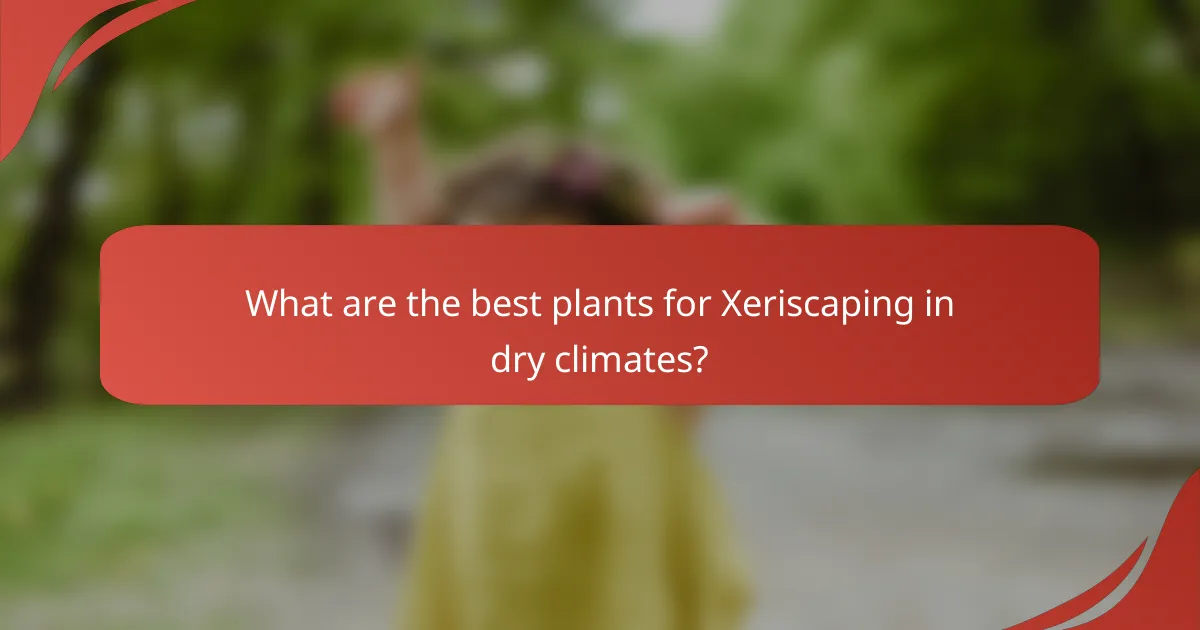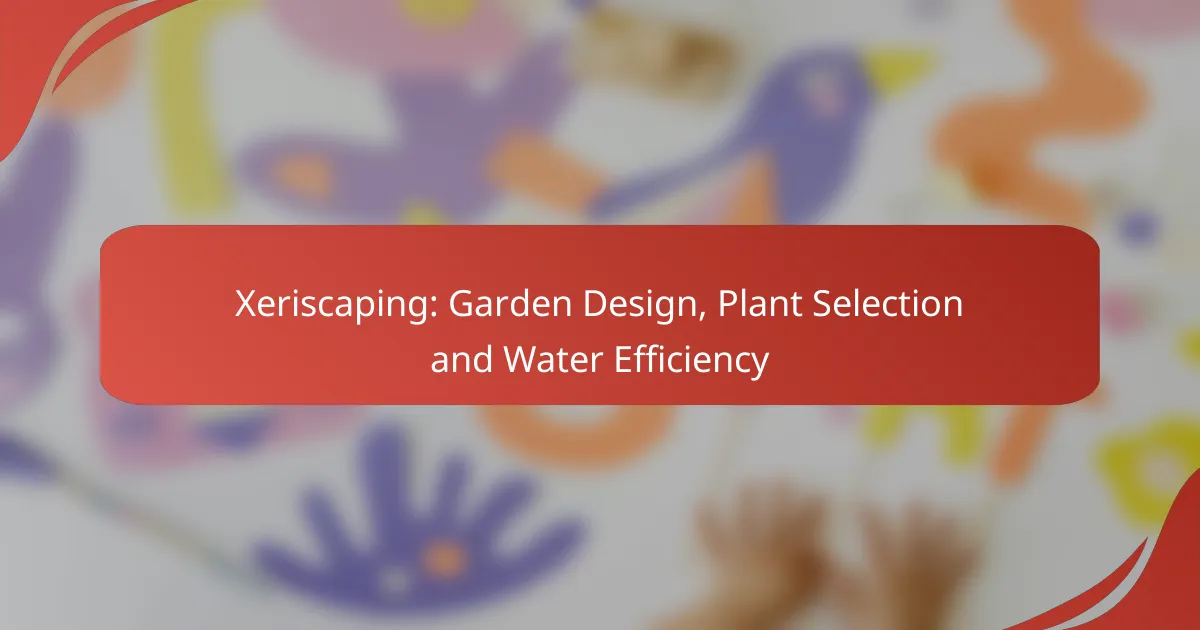Xeriscaping is an innovative gardening approach that enhances water efficiency by incorporating drought-tolerant plants and strategic landscaping techniques. This method is particularly beneficial in arid regions, as it minimizes irrigation needs and promotes sustainable gardening practices. By selecting native and drought-resistant species, xeriscaping creates vibrant landscapes that thrive with minimal water input.

How can Xeriscaping improve water efficiency in California?
Xeriscaping can significantly enhance water efficiency in California by utilizing drought-tolerant plants and efficient landscaping techniques. This approach reduces the need for irrigation, making it ideal for regions facing water scarcity.
Reduces water usage by up to 50%
Xeriscaping can cut water consumption by as much as 50% compared to traditional landscaping methods. By selecting native and drought-resistant plants, homeowners can create a vibrant garden while minimizing the need for supplemental watering.
In practice, this means choosing plants like succulents, California poppies, and lavender, which thrive in dry conditions. Implementing efficient irrigation systems, such as drip irrigation, can further enhance water savings.
Minimizes runoff and evaporation
Xeriscaping minimizes water runoff and evaporation through strategic design and plant selection. By using mulch and ground cover, homeowners can retain moisture in the soil, reducing the amount of water lost to evaporation.
Incorporating features like contouring and swales can help direct water to where it is needed most, preventing runoff. This not only conserves water but also promotes healthier plant growth and reduces the need for chemical fertilizers.

What are the best plants for Xeriscaping in dry climates?
The best plants for xeriscaping in dry climates are those that thrive with minimal water and are well-suited to arid conditions. These plants typically include native species and drought-resistant varieties that can survive long periods without rainfall.
Native California plants
Native California plants are excellent choices for xeriscaping due to their natural adaptation to the local climate. Species such as California poppy, manzanita, and sage thrive in dry conditions and require less maintenance than non-native plants.
When selecting native plants, consider their growth habits and seasonal changes. Many native plants are resilient and can provide year-round interest, with vibrant blooms in spring and summer. Grouping these plants together can create a cohesive and sustainable landscape.
Drought-resistant succulents
Drought-resistant succulents are another ideal option for xeriscaping, as they store water in their leaves, stems, or roots. Varieties like agave, aloe, and sedum are popular for their unique shapes and colors, adding visual interest to gardens.
When incorporating succulents, ensure they are planted in well-draining soil to prevent root rot. Mixing different types of succulents can create a diverse and attractive landscape, while also minimizing water usage. Regularly check for pests, as some succulents can be susceptible to infestations.

What design principles should be followed in Xeriscaping?
Xeriscaping involves specific design principles aimed at creating water-efficient landscapes. Key considerations include plant selection based on water needs, strategic placement of plants, and the use of materials that enhance moisture retention.
Use of zoning for plant placement
Zoning is essential in xeriscaping as it involves grouping plants with similar water requirements together. This method allows for efficient irrigation and minimizes water waste. For instance, drought-tolerant plants can be placed in areas that receive full sun, while more moisture-loving plants can be positioned in shaded spots.
When implementing zoning, consider the microclimates within your garden. Factors such as sunlight exposure, wind patterns, and soil type can influence plant health and water needs. Creating distinct zones can help optimize water usage and promote healthier plant growth.
Incorporation of mulch for moisture retention
Mulch plays a critical role in xeriscaping by helping to retain soil moisture and suppress weeds. Organic mulches, such as wood chips or straw, can improve soil health as they decompose, while inorganic options like gravel provide long-lasting coverage. A layer of mulch, typically 2-4 inches thick, can significantly reduce evaporation.
When applying mulch, ensure it is spread evenly around plants, avoiding direct contact with stems to prevent rot. Regularly check and replenish mulch as needed to maintain its effectiveness. This practice not only conserves water but also enhances the overall aesthetic of the garden.

How to create a Xeriscape garden layout?
Creating a Xeriscape garden layout involves designing a landscape that minimizes water use while maximizing aesthetic appeal. This approach focuses on selecting drought-resistant plants and organizing them in a way that takes advantage of natural conditions.
Plan for microclimates
Identifying and planning for microclimates is essential in Xeriscaping. Microclimates are small areas within your garden that have different environmental conditions, such as sunlight, shade, wind, and moisture levels. Understanding these variations allows you to choose plants that thrive in specific conditions, enhancing water efficiency.
For instance, a south-facing slope may receive more sunlight and heat, making it suitable for sun-loving plants, while a shaded area under a tree can support moisture-loving species. Observe your garden throughout the day to identify these microclimates and plan accordingly.
Implement pathways and hardscaping
Pathways and hardscaping elements play a crucial role in a Xeriscape garden layout. They not only provide structure and accessibility but also help manage water runoff and soil erosion. Use permeable materials for pathways to allow rainwater to infiltrate the soil, reducing the need for irrigation.
Consider incorporating features like gravel paths, stone patios, or decorative boulders. These elements can enhance the visual appeal while contributing to water conservation. Aim for a layout that minimizes the area of non-plant surfaces, focusing on functional designs that support your plant selections.

What are the costs associated with Xeriscaping?
The costs associated with xeriscaping can vary significantly based on the size of the garden, the choice of plants, and the complexity of the design. While initial installation costs may be higher than traditional landscaping, the long-term savings on water bills can make xeriscaping a financially sound investment.
Initial installation costs
Initial installation costs for xeriscaping typically range from several hundred to a few thousand dollars, depending on factors such as the size of the area and the specific plants chosen. Native and drought-resistant plants may have different price points, so researching local nurseries can help in budgeting.
In addition to plant costs, consider expenses for soil amendments, mulch, and irrigation systems. A well-planned xeriscape may require a higher upfront investment, but it can lead to reduced maintenance costs over time.
Long-term savings on water bills
Xeriscaping can lead to significant long-term savings on water bills, often reducing consumption by 50% or more compared to traditional landscapes. This is particularly beneficial in regions with high water costs or restrictions on water usage.
By selecting drought-tolerant plants and implementing efficient irrigation techniques, homeowners can enjoy lush gardens while minimizing their water expenses. Over the years, these savings can offset the initial installation costs, making xeriscaping an economically wise choice.

What tools are essential for Xeriscaping?
Essential tools for xeriscaping include efficient irrigation systems and moisture monitoring devices. These tools help conserve water while maintaining a healthy, drought-resistant landscape.
Drip irrigation systems
Drip irrigation systems deliver water directly to the roots of plants, minimizing evaporation and runoff. This targeted approach can reduce water usage by up to 50% compared to traditional watering methods.
When selecting a drip irrigation system, consider the layout of your garden and the types of plants you are using. A well-designed system will include drip emitters, tubing, and a filter to prevent clogging.
Regular maintenance is crucial; check for leaks and clogs periodically to ensure optimal performance. Additionally, using a timer can help automate watering schedules, further enhancing water efficiency.
Soil moisture sensors
Soil moisture sensors monitor the moisture levels in the soil, providing real-time data to inform watering decisions. These sensors help prevent overwatering and ensure that plants receive the right amount of moisture.
When choosing soil moisture sensors, look for models that are easy to install and compatible with your irrigation system. Some advanced sensors can connect to smartphones, allowing for remote monitoring and control.
Position sensors at various depths to get a comprehensive understanding of soil moisture levels. This practice helps in adjusting irrigation schedules based on actual needs, promoting healthier plant growth and water conservation.

How does Xeriscaping contribute to biodiversity?
Xeriscaping enhances biodiversity by creating diverse habitats that support various plant and animal species. This sustainable gardening approach uses drought-resistant plants, which can thrive in local climates while providing essential resources for wildlife.
Supports local wildlife habitats
Xeriscaping fosters local wildlife habitats by incorporating native plants that are well-adapted to the environment. These plants provide food and shelter for birds, insects, and other animals, promoting a balanced ecosystem. For instance, using local shrubs and grasses can attract beneficial species, such as butterflies and bees, which are crucial for pollination.
To maximize habitat support, consider planting a variety of species that bloom at different times throughout the year. This ensures a continuous food source for wildlife and enhances the overall resilience of the garden.
Encourages pollinator-friendly plants
Xeriscaping encourages the use of pollinator-friendly plants, which are vital for maintaining healthy ecosystems. By selecting flowering plants that attract bees, butterflies, and other pollinators, gardeners can significantly boost local biodiversity. Examples include lavender, coneflower, and salvia, which thrive in dry conditions and provide nectar and pollen.
When designing a xeriscape garden, aim to create clusters of these plants to make them more visible and accessible to pollinators. Avoid using pesticides that can harm these beneficial insects, and consider incorporating a water source, like a small birdbath, to further support local wildlife.

What are common misconceptions about Xeriscaping?
Many people mistakenly believe that xeriscaping is solely about using rocks and gravel in landscaping. In reality, xeriscaping encompasses a variety of drought-resistant plants and design principles aimed at conserving water while creating a vibrant garden.
Xeriscaping is not just rocks
Xeriscaping involves much more than just incorporating rocks into your garden. It includes a diverse range of native and drought-tolerant plants that can thrive in dry conditions, providing color and texture without excessive water use.
For example, flowering plants like lavender, succulents, and ornamental grasses can be part of a xeriscaped garden. These plants not only require less water but also attract beneficial pollinators, enhancing the ecosystem.
When planning a xeriscaped garden, consider grouping plants with similar water needs together. This practice, known as hydrozoning, helps to maximize water efficiency and minimizes waste, ensuring that each plant receives the appropriate amount of moisture.
